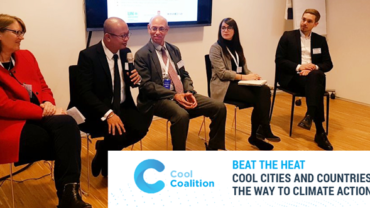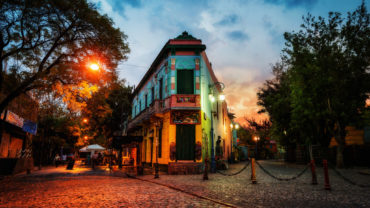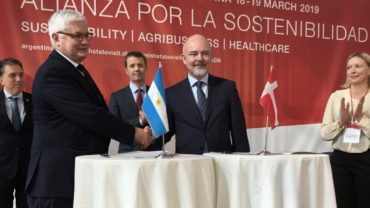Life has always been hotter in cities. Concrete soaking up and radiating sunlight, and the concentration of people, cars and machinery crank up the temperatures, making them on average 5–9°C warmer than rural areas.
This has led to fast growth of power-hungry air conditioning units delivering cooling. The problem is that this cooling has been pumping out excess heat and greenhouse gas emissions, which warm the planet and so lead to an ever-greater need for cooling.
Cities will still have to keep their citizens cool. We have already witnessed growing heat waves, both in frequency and amplitude. They severely affect the functioning and health of cities and their citizens. Rising temperatures contribute to heat-related deaths, reduced workforce productivity—estimated at 2.2 per cent of working hours lost worldwide by 2030—and poor air quality, which disproportionately affects the poorest communities. Rising temperatures mean that 1.6 billion people could face average summer temperature highs of 35°C by 2050, approximately 1.4 billion more people than today.
We need better ways to keep cool.
“About 40 per cent of energy consumed by buildings worldwide is used for space heating and cooling,” said Martina Otto, who heads the secretariat of the Global Alliance on Buildings and Construction at the UN Environment Programme (UNEP). “Space cooling is amongst the fastest-growing building end uses, and with higher temperature, more urbanites and rising standards of living, we will need a multiplicity of solutions to provide thermal comfort and protect human health.”
Active cooling needs to be cleaner and more efficient while we design buildings for more passive cooling and include nature-based solutions in buildings and cities’ public space. And we need to shift from the notion of cooling down space to providing thermal comfort.
Through the District Energy in Cities Initiative, UNEP DTU Partnership is working to create synergies between the production and supply of heating, cooling, domestic hot water and electricity, than can be integrated with municipal systems such as power, sanitation, sewage treatment, transport and waste.
The District Energy Initiative is one of six accelerators of the Sustainable Energy for All (SEforALL) Energy Efficiency Hub, hosted by the UNEP DTU Partnership’s Copenhagen Centre on Energy Efficiency.
Cities already starting to deliver
There are global and local efforts to address the energy efficiency and climate impact of the cooling sector, in particular through the Kigali Amendment to the Montreal Protocol. These actions can make a huge difference, but cities can do a lot more.
The Cool Coalition—a global network connecting over 80 partners—is working towards a rapid global transition to efficient and climate-friendly cooling. The coalition was launched in UN City Copenhagen earlier this year, and works with C40 cities and its network of more than 90 members to share expertise and integrate urban cooling into their climate action plans.
By implementing clean cooling strategies, cities can not only reduce the demand for cooling but align their policies with other areas of importance, such as air quality, public health and energy resilience.
Cities are working on innovative solutions, and C40 cities are delving deeper into them as they meet in Copenhagen this week for the C40 World Mayors Summit. These range from scaling up district cooling initiatives to cool roofs and green roofs and facades, to urban landscaping with nature-based solutions such as green corridors, a well-articulated offer of green public spaces.
“Cities have a critical role to play in delivering efficient, clean cooling for their citizens” said David Aitken, Director, Innovation at Cool Coalition partner the Carbon Trust. “In their role as a facilitator, planning authority, asset owner and financier, cities have many levers to pull that can influence the way cooling is produced and consumed. Taking action on cooling at the local level will also leverage co-benefits relating to health and wellbeing, air quality and living standards.”
There are examples from all over the world.
Following the 2010 heatwave, Ahmedabad in India developed a plan for cool roofs, awareness raising and cooling stations. Since 2013, the city has avoided an estimated 1,100 deaths per year. It has acted as a blueprint for 30 cities in India, who have now released or are developing their own plan.
As part of their commitment to the Paris Climate agreement, Melbourne, Australia is banking on nature-based solutions. The goal is to plant 3,000 trees—which provide shade, reflect sunlight and release moisture into the air through their leaves—every year and cool the city by 4°C.
Copenhagen, Denmark, uses seawater in its district cooling system, reducing CO₂ emissions by up to 30,000 tonnes per year. The goal is to expand district cooling further and contribute to Copenhagen’s target of becoming CO2-neutral by 2025. Other initiatives in Copenhagen include green roofs for municipal buildings and a smart city energy lab that demonstrates how electricity and heating, energy-efficient buildings and electric transport can be integrated into an optimized system.
Cool roofs and new building materials on the rise
Cool roofs are gaining traction globally. Through its CoolRoofs Initiative, New York City has already painted more than 5 million square feet of its roofs with a reflective coating. Meanwhile, the Global Cool Cities Alliance has launched the Million Cool Roofs Challenge, a US$2 million global competition to rapidly scale up the deployment of highly solar-reflective roofs in developing countries.
“The concept of cool roofs is simple, but implementation faces barriers in the global south,” said Kurt Schickman, Executive Director of the Global Cool Cities Alliance. “We need to raise awareness of the opportunity. The availability of coatings and other cool roof solutions is often limited or non-existent. There is a lack of financing and investment. The Million Cool Roofs Challenge seeks to address each of these challenges.”
Green roofs and facades provide thermal insulation and help clean the air by trapping particulate matter. They offer the opportunity for urban agriculture and onsite wastewater treatment, adding further benefits. Bio-based building materials, which have a lower climate impact than concrete and store less heat, also offer real potential to improve the building envelope. While concrete has a high thermal mass, it’s extremely energy intensive to produce: 8 to 10 per cent of the world’s CO₂ emissions come from cement.
“Alternatives such as bio-based materials are increasingly being used and can help reduce environmental impacts, while also providing the desired thermal mass,” said Otto. “For example, we have engaged in a partnership with Yale University to explore the use of such alternatives, from certified timber to bamboo and use of agricultural waste products such as coco fibre.”
It is clear that cities have a wide menu of options to choose from. They can walk the talk through public procurement decisions regarding their own buildings, set performance standards, use their planning authority and enter into partnerships with the private sector. By taking advantage of these options, cities can turn down the heat in the city and help put the world on track for a cooler future



